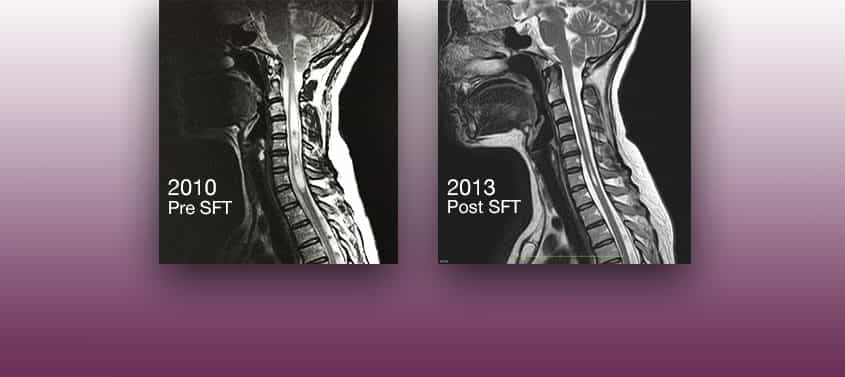
Syringomyelia
Syringomyelia
Last update: 29/01/2019, Dr. Miguel B. Royo Salvador, Medical Board number 10389. Neurosurgeon y Neurologist.
Definition
Idiopathic Syringomyelia is defined by the presence of an intramedullary cyst filled with clear fluid, within the spinal cord. Symptoms of generalized deterioration of the spinal cord (predominantly related to thermal sensitivity) are characteristic.
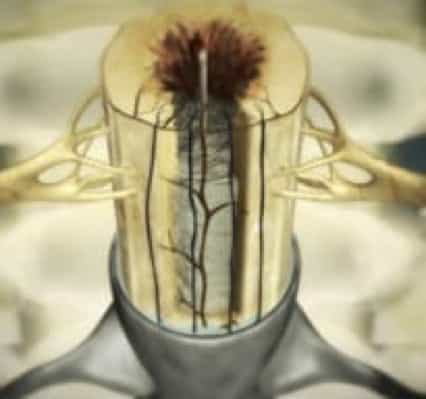
Figure 1.- Image showing the interstitial fluid or serum that fills the intramedullary cyst.
This is the result of the nervous tissue death, caused by the ischemia-oedema
produced by the traction from the filum terminale.
Described by: Estienne in 1546 in “La disection du corps humain”.
Named by: the anatomist Charles Prosper Ollivier d’Angers (1796–1845) in Paris in 1824, and published in his “Traité de la moelle epinière et ses maladies”.
Incidence: 84 cases per million people. According to the Filum System® criteria, the incidence is much higher.
Symptoms
The most frequent symptoms of idiopathic syringomyelia in our patients (from more to less recurrent) are: pain in extremities, neck ache, thermal and pain sensitivity alterations, lower back pain, upper back pain, headache, gait alterations, paresis, sphincter alterations.
Types of Syringomyelia
A. Primary or idiopathic Syringomyelia. Idiopathic Syringomyelia is a fluid-filled intramedullary cyst. The cause of its formation is unknown.
B. Secondary Syringomyelia. Secondary Syringomyelia is an intramedullary cyst filled with interstitial fluid or serum, the cause of which is tumorous, traumatic, infectious or other. Its cause could produce a necrosis of the spinal cord parenchyma, exerting an invasive effect by compression, traction or a combination of the 3 mechanisms.
Cause of Idiopathic Syringomyelia: Theories
– Conventional theories:
- Hydrodynamic theory: the formation of an intramedullary cyst is the consequence of a CSF flow abnormality.
- Malformation theory: the theory of a small cranial fossa conceives that this malformation induces the cerebellum to herniate into the spinal canal, producing a hydrodynamic conflict which causes a deviation of the fluid towards the inside of the spinal cord, thus generating the syringomyelic cavitation.
– The Cord Traction Theory according to the Filum Filum System®:
Dr. Miguel B. Royo-Salvador’s theory considers the syringomyelic cavitation as the result of nervous tissue necrosis, caused by the ischemia-oedema produced by the traction from an overly tense film terminale (not detectable on imaging). The syringomyelic cavitation is filled with interstitial fluid or serum. During its evolution, it can fistulize into the perimedullary space or the ependymal canal and exchange interstitial fluid with cerebrospinal fluid.
– Filum Disease:
Dr. Royo-Salvador, with his research and doctoral thesis (1992), proved the theory that considers several diseases of unknown cause (Arnold-Chiari Syndrome Type I, idiopathic Syringomyelia, idiopathic Scoliosis, platybasia, basilar invagination, odontoid retroflexion, brain stem kinking, and others) as part of a new disease concept (the Filum Disease) and that they share a common cause (spinal cord and entire nervous system traction).
The traction force of the entire nervous system in the Filum Disease occurs in all human embryos, hence they all suffer its consequences to a greater or lesser extent, and the consequences manifest in many different ways and intensities.
Other diseases, such as herniated discs, some cerebral vascular insufficiency syndromes, facet joint and Baastrup syndromes, fibromyalgia, chronic fatigue, nocturnal enuresis, urinary incontinence and pronounced paraparesis, are related, due to their cause, to the Filum Disease.
A health method, the Filum System®, has been designed to specify the diagnosis, provide guidance for the treatment and follow-up of the Filum Disease.
Risk factors in Idiopathic Syringomyelia
The most influential risk factors for the development of Idiopathic Syringomyelia are the following:
- Family history: The caudal traction of the entire nervous system produced by an excessively tense Filum terminale, which we define as Filum Disease, can cause a mechanism of lack of blood flow in the spinal cord and can further develop into necrosis of the nervous tissue and the consequent intramedullary cysts. It is a congenital condition that can be inherited between family members.
- A sudden increase of the cord traction: It has been observed that the spinal cord traction can increase after an accident, fall or trauma to the spine – with a spinal cord that is already congenitally suffering from the Filum Disease. In these circumstances of greater caudal cord traction, a worsening of the syringomyelic cavitation can be observed. In these cases, the cause of the syringomyelia is not the accident (like in post-traumatic cases), but it triggers a sudden worsening of the pre-existing traction mechanism.
Complications of Idiopathic Syringomyelia
Complications of Idiopathic Syringomyelia in the Filum Disease may depend on the involvement of the spinal cord and blood flow within it, due to the caudal traction. This can cause the deterioration of mainly motor and sensitive functions, which can lead to severe complications for the patient:
- Loss of autonomy: the neurological involvement and progressive muscle atrophy of the extremities, with paresis and asthenia, can produce a loss of the ability to walk or to use arms and hands.
- Chronic pain: pain-related symptoms and sensitivity alterations can become persistent and very intense.
Treatment of Idiopathic Syringomyelia
The conventionally accepted treatment for Idiopathic Syringomyelia is neurosurgical.
Conventional
Currently, the ventriculoperitoneal shunting or arachnolysis is the standard treatment performed in most centres worldwide for this diagnosis. Usually this indication is especially for severely symptomatic cases, as it causes more morbidity and mortality than the natural evolution of the condition itself.
The syringomyelic cavitation shunting does not eliminate the cause of the disease. It is applied to treat one of the consequences or sequelae – the accumulation of fluid – by perforating the already damaged spinal cord. For this reason we consider this surgery to be contraindicated.
Filum System®
Since 1993, however, with the publication of Dr Royo-Salvador’s doctoral thesis, which links the caudal traction of the entire nervous system due to the filum terminale to being the cause of the syringomyelic cavitation – among other diseases -, a new treatment has been designed. It is in this case etiological (cause-related) since the caudal cord traction force responsible for the pathological mechanism is eliminated by surgically sectioning the filum terminale.
The sectioning of the Filum Terminale with minimally invasive technique is one of the protocolized surgeries within the Filum System® health method.
It usually is indicated as soon as possible in all cases, from mildly to severely symptomatic, as its risks are minimal, much lower than those of the condition itself, and it also stops the condition’s progression.
Minimally invasive sectioning of the Filum terminale according to the Filum System®:
Syringostomy
(shunting of the syringomyelia cavitation)
Sectioning of the Filum Terminale: Outcomes
More than 1.500 idiopathic Syringomyelia patients, with or without idiopathic Scoliosis and/or Arnold-Chiari Syndrome type I, have already undergone surgery according to the Filum System® method.
The purpose of the surgical procedure is to stop the evolution of the disease and to prevent the intramedullary cysts and the lesions from increasing further. Nevertheless, in some cases remarkable improvements of the clinical status have been achieved, even including a reabsorption of the fluid followed by a collapse of the cavitation.
Examples
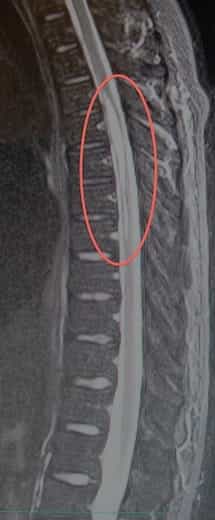
2008
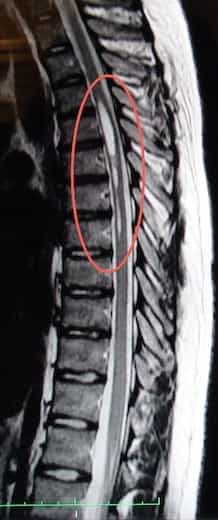
2009
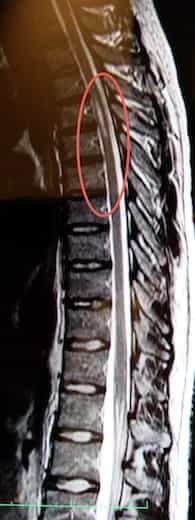
2010
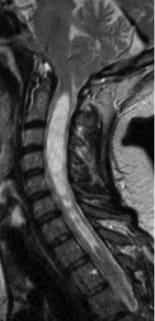
2006
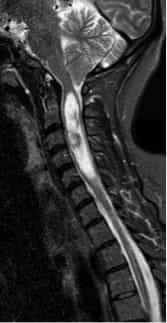
2014

2010
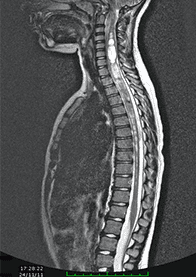
2011

2016
References:
- Dr. Miguel B. Royo Salvador (1996), Siringomielia, escoliosis y malformación de Arnold-Chiari idiopáticas, etiología común (PDF). REV NEUROL (Barc); 24 (132): 937-959.
- Dr. Miguel B. Royo Salvador (1996), Platibasia, impresión basilar, retroceso odontoideo y kinking del tronco cerebral, etiología común con la siringomielia, escoliosis y malformación de Arnold-Chiari idiopáticas (PDF). REV NEUROL (Barc); 24 (134): 1241-1250
- Dr. Miguel B. Royo Salvador (1997), Nuevo tratamiento quirúrgico para la siringomielia, la escoliosis, la malformación de Arnold-Chiari, el kinking del tronco cerebral, el retroceso odontoideo, la impresión basilar y la platibasia idiopáticas (PDF). REV NEUROL; 25 (140): 523-530
- M. B. Royo-Salvador, J. Solé-Llenas, J. M. Doménech, and R. González-Adrio, (2005) “Results of the section of the filum terminale in 20 patients with syringomyelia, scoliosis and Chiari malformation“.(PDF). Acta Neurochir (Wien) 147: 515–523.
- M. B. Royo-Salvador (1992), “Aportación a la etiología de la siringomielia“, Tesis doctoral (PDF). Universidad Autónoma de Barcelona.
- M. B. Royo-Salvador (2014), “Filum System® Bibliography” (PDF).
- M. B. Royo-Salvador (2014), “Filum System® A brief guide.”.


















